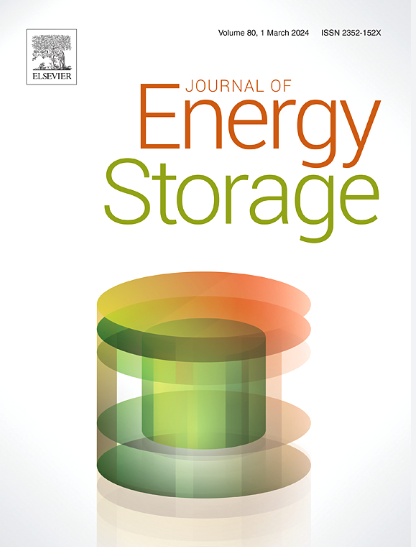基于文献计量学和数学模型分析的储氢可持续性研究综述
IF 8.9
2区 工程技术
Q1 ENERGY & FUELS
引用次数: 0
摘要
利用氢气的一个主要挑战是开发经济、安全的储存解决方案。本研究探讨低温和吸附技术的生物氢储存,强调其操作能力。值得注意的是,在70 MPa压力下,低温储存方法的密度是压缩储存方法的两倍。活性炭吸附技术为最小化与氢储存相关的爆炸风险提供了一个可行的选择。在评估的高容量存储材料中,来自非洲棕榈油的材料表现出6.5 wt%的存储容量,紧随其后的是竹子的6.6 wt%和壳聚糖的6.77 wt%,所有这些材料在4到20 MPa的压力范围内。此外,本文还介绍了利用金属和合金(如镁)通过纳米技术进行储氢的方法。这篇综述全面检查了利用Scopus数据库的文献计量分析,以“氢储存可持续性”为中心。利用VOSviewer和Excel对研究趋势、每个国家的文献数量和引用数量进行的研究显示,“绿色氢”、“脱碳”和“能源转型”等关键词目前是趋势,为进一步发展可持续氢储存提供了潜力。一个关键的考虑因素包括评估数学模型,这些模型结合了各种案例研究和专注于氢储存的设计。几个案例研究探索了不同的储氢方法,包括地下储氢、高压储氢罐、快速充氢和储氢系统以及压缩低温储氢。通过分析数学模型和文献计量数据,本研究可以为未来学者在可持续储氢领域的发展提供宝贵的资源。本文章由计算机程序翻译,如有差异,请以英文原文为准。
Review of hydrogen storage sustainability using bibliometric and mathematical modeling analysis
A primary challenge in utilizing hydrogen is developing economical and secure storage solutions. This study examines cryogenic and adsorptive technologies for biohydrogen storage, emphasizing their operational capacities. Notably, cryogenic storage methods demonstrate a density double that of compressed storage at 70 MPa pressure. The activated carbon adsorption technique offers a viable option for minimizing explosion risks associated with hydrogen storage. Among the materials assessed for high-capacity storage, those derived from African palm oil exhibit a storage capacity of 6.5 wt%, closely followed by bamboo at 6.6 wt% and chitosan at 6.77 wt%, all under pressures ranging from 4 to 20 MPa. Additionally, the review includes hydrogen storage using metals and alloys such as magnesium, approached through nanotechnology. This review comprehensively examines bibliometric analysis utilizing the Scopus database, centered on “hydrogen storage sustainability.” The study of research trends, the number of documents per country, and the number of citations using VOSviewer and Excel revealed that keywords such as “green hydrogen,” “decarbonization,” and “energy transition” are currently trending, offering the potential for further development in sustainable hydrogen storage. A critical consideration involves evaluating mathematical models that incorporate various case studies and designs focused on hydrogen storage. Several case studies have explored different hydrogen storage methods, including underground storage, high-pressure tanks, rapid filling and storage systems, and compressed cryogenic storage. By analyzing mathematical models and bibliometric data, this research can serve as a valuable resource for future scholars aiming to advance the field of sustainable hydrogen storage.
求助全文
通过发布文献求助,成功后即可免费获取论文全文。
去求助
来源期刊

Journal of energy storage
Energy-Renewable Energy, Sustainability and the Environment
CiteScore
11.80
自引率
24.50%
发文量
2262
审稿时长
69 days
期刊介绍:
Journal of energy storage focusses on all aspects of energy storage, in particular systems integration, electric grid integration, modelling and analysis, novel energy storage technologies, sizing and management strategies, business models for operation of storage systems and energy storage developments worldwide.
 求助内容:
求助内容: 应助结果提醒方式:
应助结果提醒方式:


